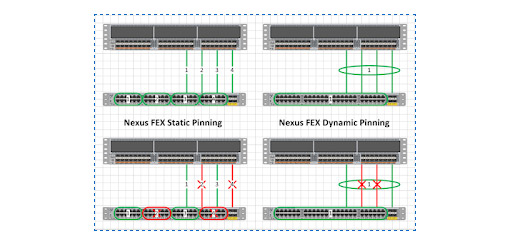The Nexus 2000 Fabric Extender does not perform any local switching functions, and all traffic is forwarded to the parent switch such as Nexus 5K,7K,9K.
The Nexus 2200 Fabric Extenders can be connected to the parent switches using two different methods,
a) Static interface pinning
b) Dynamic interface pinning
Static interface pinning :
* In Static Interface Pinning method, A group of ports in Fabric Extender and assign this ports manually with one uplink for sending traffic to the parent switch.
* If one particular uplink fails, a group of FEX ports associated with this uplink, fail as well.
* The pinning is based on the number of uplinks available to the Parent Switch.
* Static pinning is recommended when you want tight control over the bandwidth and oversubscription in the network.
Dynamic interface pinning
* In Dynamic Interface Pinning method, we use port channel to connect from Fabric Extender to Parent Switch instead of connecting the interfaces directly.
* If one of the particular uplink fails, a group of FEX ports associated with this uplink does not fail as we are using port channel to connect parent switch.
* The choice of pinning mode depends upon the way how the servers are connected to the access switches.
* For dual-homed servers, static pinning results in more deterministic oversubscription ratios. However, for single-homed servers, dynamic pinning provides increased availability.
Configuration of Pinning :
N5K(config-fex)# description FEX100
N5K(config-fex)# exit
N5K(config)# interface ethernet 1/1
N5K(config-if)# switchport mode fex-fabric
N5K(config-if)# fex associate 100
N5K(config-if)# no shutdown
N5K(config)# interface ethernet 1/2
N5K(config-if)# switchport mode fex-fabric
N5K(config-if)# fex associate 100
N5K(config-if)# no shutdown
